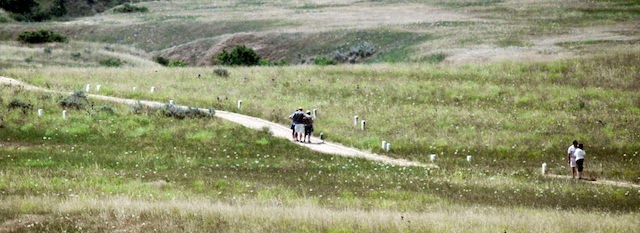We have but a week left in Florence, which leaves us caught between two flavors of tourism. Do we rush to see more of the "big" sites or do we casually browse the back alleys and the Italian lifestyle.
The past few days have found us doing both.
 |
| The dome dominates the Florence skyline |
No one can visit Florence without a trip to
Il Duomo. Officially the Basilica di Santa Maria del Fiore, it is the largest masonry dome ever built -- nearly twice the size of the U.S. Capitol. It looms over the Florence skyline and draws your eye from every vantage.
We put off touring the dome because of the long lines of tourists always waiting to get in. But Thursday we got up early and found only short line before before 9 a.m. Tickets in hand, we entered a stone doorway that led 300 feet to the top.
It's breathtaking. And the views are great. The 463-step climb up shoulder-wide stone stairs, though, was the the 15th-century equivalent to a stress EKG.
 |
| Down, but we went up |
 |
| Dome art |
Il Duomo was designed by Fillipo Brunelleschi in 1420 to cap the rectangular basilica that had awaited a top for nearly 200 years.
Brunelleschi was a goldsmith rather than an architect, but he was a true Renaissance man who believed -- with good reason -- that he could do anything. He stunned the backers of the project by saying he could build the world's biggest dome without propping up the pieces with wood beams during construction. Good thing, too, because Italy didn't have trees that big.
 |
| View from the top of Il Duomo |
He built mind-boggling cranes and used techniques that still amaze engineers. National Geographic had a good recent article about
Brunelleschi's Dome.
The interior dome is of course a canvas for spectacular art and the work of Renaissance masters fills every nook.
But the other masterpiece you have to see is a brisk walk away at the Accademia Museum. Michelangelo's
David is likely the most recognizable statue in the world.
 |
| David |
Our "Uffizi friend" cards let us get in via a shorter line while the eager hordes waited along the street. But any line would be worth seeing this once in your life. I know that I've seen hundreds of photos and drawings of
David in my life, but none prepared me for the detailed beauty of the statue.
Michelangelo liked men both dead (as research cadavers) and alive (as romantic interests). He studied the male body in infinite detail. He gave
David nuances of musculature, expression and pose that I know from personal experience are hard to capture with a camera.
The museum also houses his unfinished
The Prisoners and Giambologna's
Rape of the Sabine Women. One of the fun parts, however, is the reminder that the name Accademia meant that it was originally a school. In one room there are dozens of plaster casts of statues plus scores of plaster busts that were the capstone projects for students.
Our last check on the Florence Bucket List was the Boboli Gardens -- once the private rest-and-recreation preserve of the Medici family. We actually climbed through the hillside garden on our "casual" day Wednesday. It was cool and sunny -- a change from the recent alternating oven or rain -- so we just walked out the door and discussed which corner to turn at next.
 |
| Boboli Gardens selfie |
The formal gardens are pretty and the view wonderful. But we were ready for something else so wandered to the backside of the Bobili. It's crossed with gravel lanes and punctuated by deteriorating ancient statues. There are plenty of nooks where you can rest and the rows of trees dampen the city noise.
From the rear exit of the Bobili, we wandered back streets. And such wonderful backstreets. We went through a neighborhood of artisans, filled with the shops of leatherworkers, book binders, graphic artists and jewelers. I don't think I've ever had such fun window shopping.
 |
| Just another day on Florence backstreets |
When hunger overtook us, we stopped at the Bianchi Bar ("bar" means small cafe in Italian). Family restaurants here don't operate like McDonald's. The waiter told us he had one baguette sandwich and a hamburger left in the kitchen. But if Cecile would take the sandwich, he would grill some ham on toast for me. Good enough. Especially with a Peroni beer. Which became two Peroni beers as we sat, relaxed and watched the parade of both Italians and tourists go by.
Our other "stealth" adventure was to the opera Friday night. Not to a huge opera house, but to the small St. Mark's Episcopal Church on a back street. You don't get big protestant churches in Florence.
A company of singers has offered operas at the church for years, but you often only hear of them by word of mouth. The venue is so small that it fills with ease.
 |
| Up close with Verdi |
It was delightful. We watched a somewhat-condensed version of Verdi's La Traviata. It was all done with four singers, two extras, a narrator and a pianist -- who were about 15-feet from us. The "playhouse" had domed ceiling, hanging brass lamps and wall plaques commemorating the Welsh, Coldstream and Scots Guards who fell during the Italian Campaign.
I'm not a great fan of opera, but loved this. I'd now like to see a full performance of La Traviata in comparison.




















































